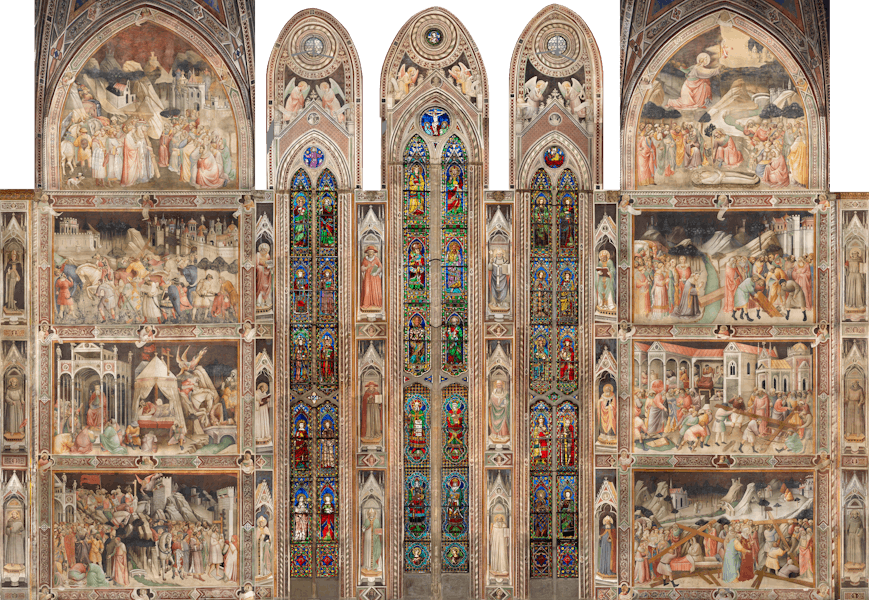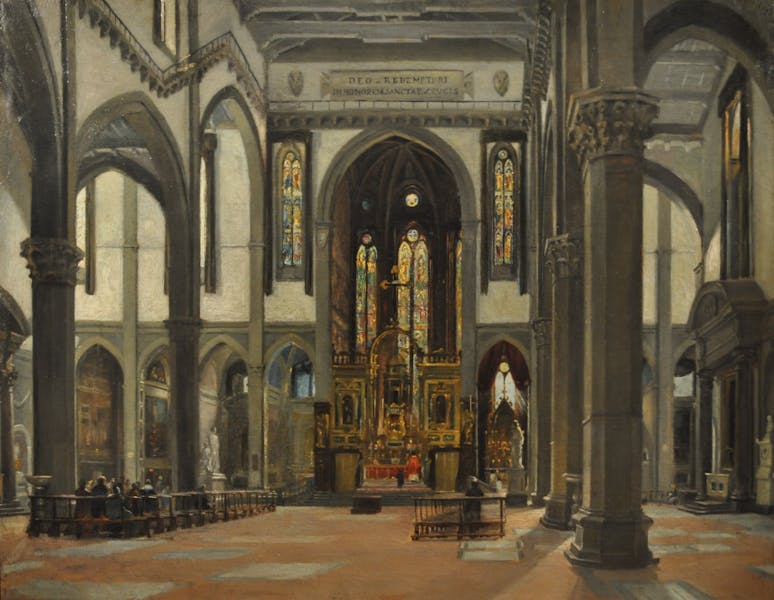
Chancel Chapel
The chancel chapel dominates the nave of the basilica with its stage-like magnificence enhanced by the most extensive figurative cycle in the whole of Santa Croce.
The altar's patrons were the Alamanni, a wealthy and powerful family of bankers who commissioned an altarpiece in the shape of polyptych from Ugolino di Nerio c. 1324–6. Subsequently dismantled, only a few of the polyptych's panels have been found and are now on display in various foreign museums.
The heads of the five branches of the Alberti family, who were leading members of the Florentine merchant and banking class, reached an agreement with the friars in 1348 to build the chancel chapel, which involved altering the church's original plan, and to be granted its patronage. That same year Albertaccio di Lapo degli Alberti left money in his will to build and decorate the chapel and his initiative was emulated by other members of the family, who were also granted patronage over the part of the transept immediately in front of it with attendant burial rights. Most of the stained-glass windows with figures of saints and apostles, attributed to Taddeo Gaddi also date back to this period.
In 1380 Jacopo degli Alberti commissioned Agnolo Gaddi to paint a cycle of frescoes depicting the Legend of the True Cross, reflecting the dedication of both the chancel and the church as a whole. The dating of the fresco cycle is still controversial, though it is generally accepted as being between 1388 and 1390. The frescoes illustrate the long history of the wood used to make the Cross of Christ as recounted by Jacobus de Varagine in his Golden Legend. They should be read from top to bottom, starting on the right-hand wall then criss-crossing with the wall opposite, descending register by register. The vault has the figures of St. John the Baptist, St. Francis and the Evangelists, while saints close to Franciscan spirituality adorn the pilasters.

Agnolo Gaddi, Legend of the True Cross, 1380-90. Basilica of Santa Croce, nave, chancel chapel
Restoration from 2005 to 2011 has revealed the technical skill of Agnolo Gaddi whose narrative, rich in detail, reveals a keen interest in the Late Gothic style.
The chapel was adapted to the dictates of the Council of Trent in the late 1560s, with the altar being moved closer to the nave in order to allow the 15th century choir carved by Manno de' Cori to be moved into the chancel, while the 14th century altarpiece was replaced by a ciborium, or canopy, completed by Vasari in 1569 and subsequently endowed with an imposing wooden frame.

Florentine artist, Interior of the Church of Santa Croce, mid-19th century. Santa Croce Historical Archive
The Royal Commission for Fine Arts ruled in 1869 that the Counter-Reformation structure should be removed because it impaired people's view of the frescoes. Its place was taken on the renovated high altar by a polyptych designed by the architect Niccolò Matas and assembled using paintings attributed to Florentine followers of Giotto.
A Crucifix painted by the Master of Figline in the mid-14th century was hung in the chapel in the 1930s and restored in 2014.